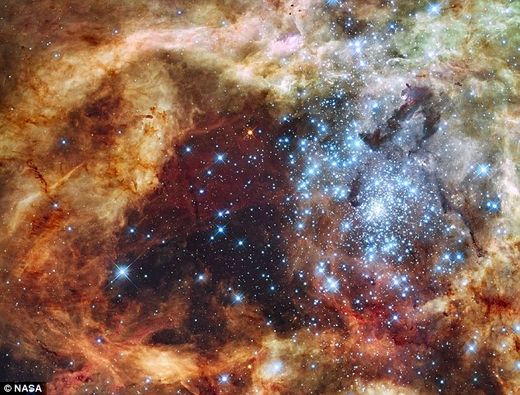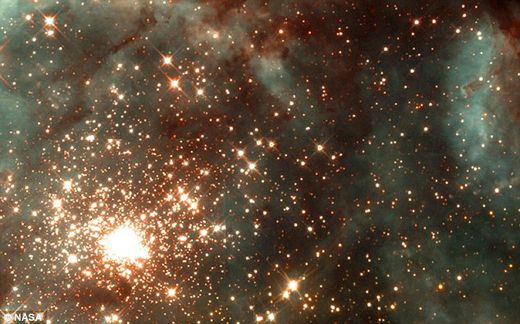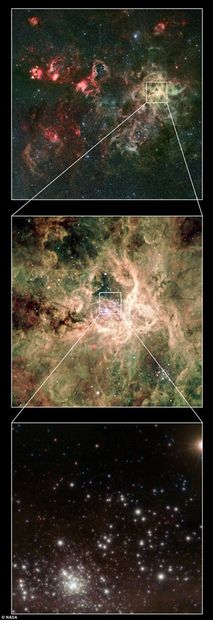
In 2010, NASA scientists discovered four stars which absolutely dwarf anything that comes before them - they are 300 times as massive as the Sun, and twice as large as it was predicted stars could ever be.
Now researchers at the Bonn University in Germany, say the stars, part of the giant star cluster R136 in the Large Magellanic Cloud, which is about 160,000 light years from Earth, could be the size they are thanks to a few mergers and acquisitions.
Until the discovery of these objects in 2010, observations of the Milky Way and other galaxies suggested that the upper limit for stars formed in the present day universe was about 150 times the mass of the Sun.
This value represented a universal limit and appeared to apply wherever stars formed.
'Not only the upper mass limit but the whole mass ingredient of any newborn assembly of stars appears identical irrespective of the stellar birthplace', said Prof. Dr Pavel Kroupa of the University of Bonn, a co-author on the new paper.

The newly discovered four ultrabright ultramassive stars in R136 are quite an exception to this widely accepted limit.
The Bonn group, also including lead investigator Dr Sambaran Banerjee and team member Seungkyung Oh, modelled the interactions between stars in a R136-like cluster. Their computer simulation assembled the model cluster star by star, so as to resemble the real cluster as closely as possible, creating a cluster of more than 170,000 stars packed closely together.
At the outset Seungkyung ensured that the stars were all of a normal mass and were distributed in the way expected.
To compute how even this relatively basic system changes over time, the model had to solve 510,000 equations many times over. The simulation is complicated by the effect of the nuclear reactions and hence energy released by each star and what happens when two stars happen to collide, a frequent event in such a crowded environment.

'Once these calculations were done, it quickly became clear that the ultramassive stars are no mystery', adds Sambaran. 'They start appearing very early in the life of the cluster.
'With so many massive stars in tight binary pairs, themselves packed closely together, there are frequent random encounters, some of which result in collisions where two stars coalesce into heavier objects. The resulting stars can then quite easily end up being as ultramassive as those seen in R136.
'Imagine two bulky stars closely circling each other but where the duo gets pulled apart by the gravitational attraction from their neighbouring stars. If their initially circular orbit is stretched enough, then the stars crash into each other as they pass and make a single ultramassive star', Sambaran explains.
'Although extremely complicated physics is involved when two very massive stars collide, we still find it quite convincing that this explains the monster stars seen in the Tarantula', said Banerjee.
'This helps us relax', concludes Kroupa, 'Because the collisions mean that the ultramassive stars are a lot easier to explain.
'The universality of star formation prevails after all.'



Reader Comments
to our Newsletter